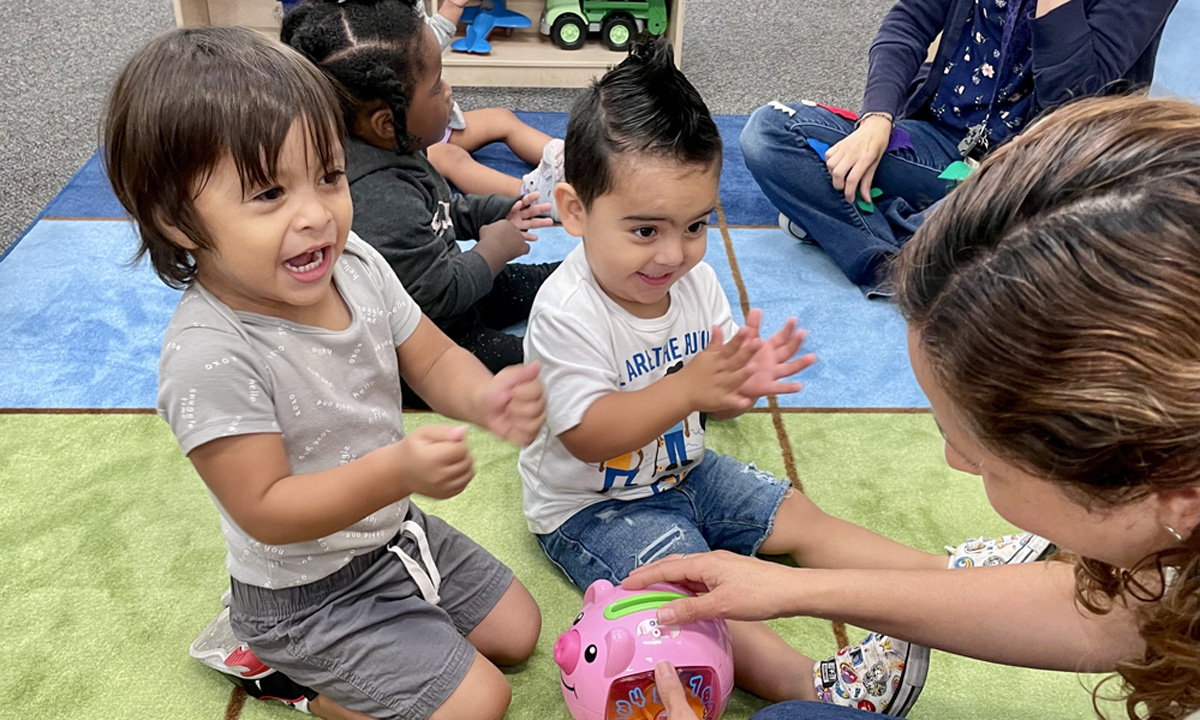Good for All Kids, Pre-K Programs Are Especially Beneficial for English Learners
Our divisive politics around immigration lag behind the diverse reality of our schools — and for English learners, early ed is a key to success.

For all the campaign arguments about immigration and the United States border, you’d think that we were embarking upon a new situation, something coming, an arriving novelty barely visible over the horizon. And yet, as far as schools are concerned, this is a past tense debate. The U.S.’s demographic reality is already shifting in remarkable ways, many of which are being driven by immigration patterns.
Cohorts of younger Americans are more diverse than older Americans in essentially every way. In 1986, 70% of U.S. K–12 students were white, just shy of 10% were Latino, and not quite 3% were Asian or Pacific Islander. In 2022, U.S. K–12 enrollment was 44% white, 29% Latino, and 5% Asian or Pacific Islander. Similarly, in 2022, roughly 21% of school-aged children spoke a non-English language at home — in 1990, it was under 14%. Go younger, and linguistic diversity grows. In 2022, roughly 1 in 3 children under 5 years old spoke a non-English language at home.
Our politics are badly lagging our educational reality. As I’ve written many times — echoing experts like demographers Dowell Myers and Bill Frey (and others) —this new diversity is a huge advantage for the United States. However else you feel about the American present and future — particularly in light of the horrifying lies perpetuated against Ohio’s immigrant communities by the Republican presidential and vice presidential nominees — there’s no factual dispute about the benefits that immigrants bring to the country. Immigrants sustain growth in the U.S. economy and labor market (boosting GDP by some $7 trillion in the next decade, according to the Congressional Budget Office), which leads to greater public revenue via taxes. And all of this is to say nothing of the immense value of these children’s rich linguistic and cultural assets.
But the extent of these benefits depends on schools’ abilities to take advantage of them — and American public education has plenty of room for improvement when it comes to supporting diverse kids. What’s the best way to help young Latino students and/or young kids who are still developing proficiency in both English and another language, known as dual language learners, or DLLs? It’s one of the most stable findings in education research: These kids uniquely benefit from early education programs.
And yes, if you’re thinking, “surely pre-K programs are good for all kids,” you’re not entirely wrong. For years, economists, developmental psychologists, education researchers, and a wide range of advocates (me too) have touted early education investments as a high-yield strategy for helping kids succeed. It’s true! Countless studies have shown that access to high-quality early education programs helps improve short-term outcomes like children’s readiness for kindergarten, as well as long-term outcomes like raising their earnings in adulthood.
And yet, recent research has provided a reminder that the success of educational interventions has more to do with implementation quality than with brand and good intentions. If high-quality pre-K can improve opportunities and outcomes for children, it’s also true that quality doesn’t come automatically just because the public invests in early education (particularly in hastily assembled and implemented systems).
For instance, recent research on Head Start has been somewhat mixed. The Head Start Impact Study produced some discouraging findings, with the academic bonuses for students “fading out” over time, but subsequent analyses have been more positive. As a Brookings summary of the state of the research put it, “Natural experiments of the effects of Head Start show that Head Start causes better health, educational, and economic outcomes over the long term as a consequence of participation, though the effect sizes are smaller than those from the model programs.”
But there is little research debate about early education program’s benefits for dual language learners. Indeed, even though a 2018 study of Tennessee’s state pre-K program found some discouraging overall outcomes for students, it still found that “non-native English speakers” showed stronger gains than other groups.
Why? It’s simple: dual language learners appear to uniquely benefit from early education programs because these programs give them an early start on English acquisition and sometimes provide them with opportunities to keep growing in their native languages.
First, it appears that the earlier that these early ed students begin the process of learning English, the better they do in the long run. Pre-K programs that offer some instruction in English can help these kids get a jump on the expected five- to seven-year window that it takes for most students to reach proficiency in English — and during an age span when their brains are more neurologically flexible. Indeed, an MDRC study of the federal Head Start program found strong academic benefits for dual language learners, which appeared to be linked to early English exposure.
Second, their native languages are powerful assets for these children in the long run. Early education programs are much more likely than K–12 schools to be staffed by bilingual teachers, which makes it easier for them to continue to develop their first languages and English simultaneously. Studies generally find that children who develop strong speaking and/or reading abilities in their native languages do better at learning English over time. It’s not yet clear exactly why this is, but it may be because their native language abilities often include transferable skills — stronger Spanish speakers and readers are also stronger users of verb tenses who better understand sentence structure and nuances of conveying meaning through language.
In other words, dual language learners do best when we — when early education systems — prioritize their development in all the languages they’re learning. And notwithstanding the pull of backwards-looking discourse that demonizes immigrants in search of political gains, we all do better when young English learners —many of whom are children or grandchildren of immigrants — succeed at school.
Get stories like these delivered straight to your inbox. Sign up for The 74 Newsletter


